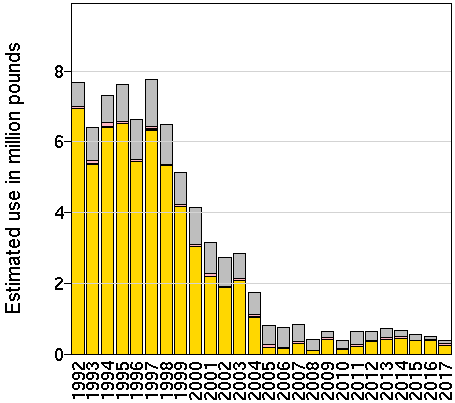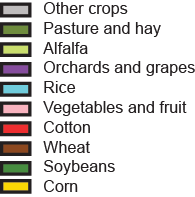Terbufos
ter-bu-fos
Primarily used on corn. Registered as a U.S. pesticide in 1973. Reregistered in 2006. Currently under registration review.
Overview
Terbufos is used in 19 states.

Terbufos is used in Alabama, Colorado, Delaware, Florida, Georgia, Illinois, Iowa, Maryland, Minnesota, Missouri, New Jersey, North Carolina, North Dakota, Ohio, Pennsylvania, South Carolina, Virginia, Wisconsin, and Wyoming.
Data is not available for Alaska, D.C., Hawaiʻi, and U.S. Territories. Data represents the most recent year available from USGS. Details.
See detailed maps of terbufos usage by state and county.
Human Health Effects
Even at low levels of exposure, terbufos can lead to serious negative health effects.
Neurodevelopmental Harm
High Residue Foods
Where residue levels of terbufos exceeded allowable limits or were not legally allowed to have residues. Details.
[No high residue foods were specifically identified from the USDA’s PDP database.]
No detection does not necessarily mean there are no residues of concern. A relatively small sample of food products is tested and not all organophosphate pesticides are tested for.
Moreover, current U.S. pesticide tolerance levels are not protective against neurodevelopmental harm in children, so detections at or below tolerance levels do not indicate no harm.
Registered Uses
Where EPA allows terbufos to be used.
Corn
Sorghum
Sugar Beets
Additional Information
Estimated Use of Terbufos on Crops
Most recent agricultural crop usage data as provided by the U.S. Geographical Survey’s Pesticide National Synthesis Project. Does not reflect universal usage of terbufos. (How do EPest-low and EPest-high differ?)
U.S. Tolerances Categories & Commodities for Terbufos
The U.S. EPA sets maximum residue limits — known as “tolerances” — on the amount of terbufos that may remain in and on foods. The tolerance is the residue level that triggers enforcement actions.
Tolerances have been set for terbufos for: Agricultural Commodities. Maximum residue limits have been set for terbufos by the U.S. EPA for the following commodities: Banana, Beet, Coffee, Corn, Sorghum.
U.S. EPA Human Health Risk Assessments for Terbufos
Human Health Risk Assessments are conducted by the U.S. EPA to estimate the nature and probability of harmful health effects in people who may be exposed to pesticide. They are used to make informed decisions about approving new pesticides and new uses of registered pesticides, and during our regular review of existing pesticides. Read the assessment for terbufos.


